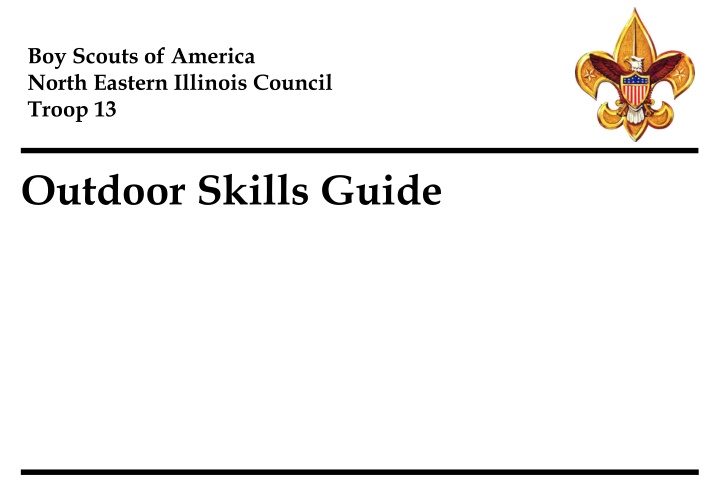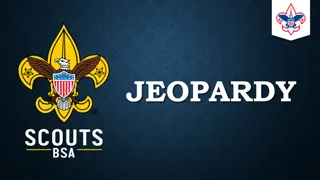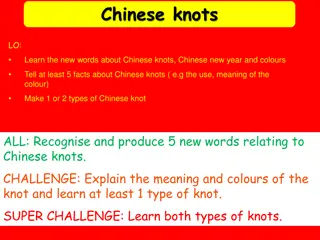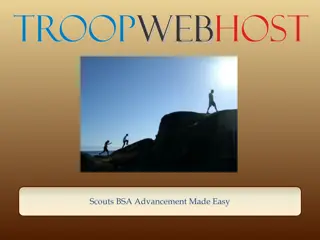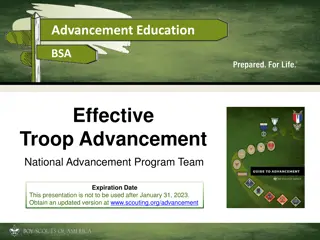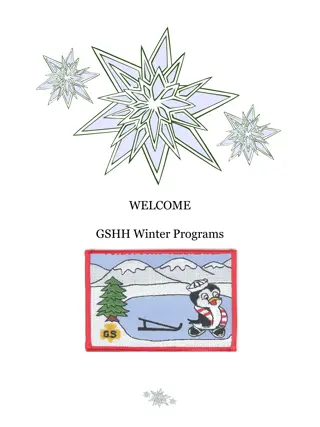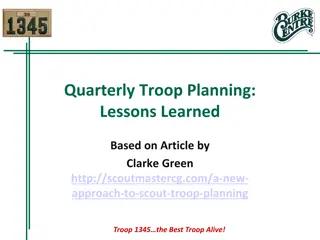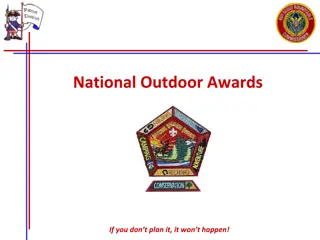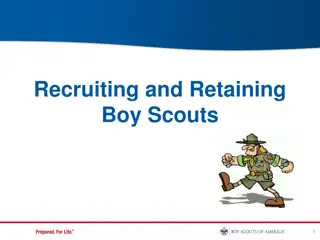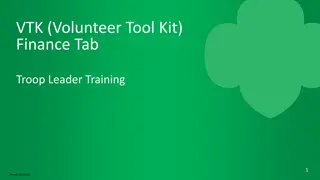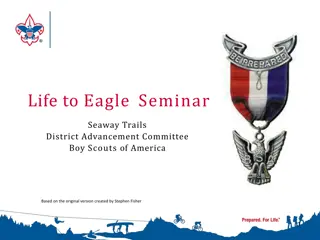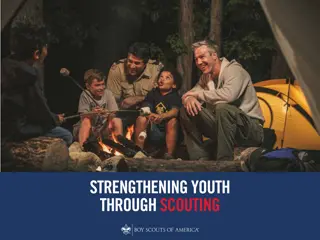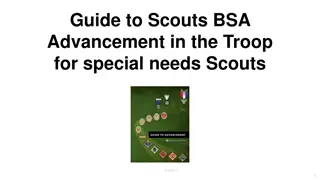Boy Scouts of America Northeastern Illinois Council Troop 13 Outdoor Skills Guide - Knots, Tracks, and Navigation
Explore the essential outdoor skills guide provided by the Boy Scouts of America Northeastern Illinois Council Troop 13, covering topics such as knots for advancement, animal track recognition, plant identification, and navigation techniques. Learn how to tie various knots, identify animal tracks, recognize plants, and navigate the wilderness effectively.
Download Presentation

Please find below an Image/Link to download the presentation.
The content on the website is provided AS IS for your information and personal use only. It may not be sold, licensed, or shared on other websites without obtaining consent from the author.If you encounter any issues during the download, it is possible that the publisher has removed the file from their server.
You are allowed to download the files provided on this website for personal or commercial use, subject to the condition that they are used lawfully. All files are the property of their respective owners.
The content on the website is provided AS IS for your information and personal use only. It may not be sold, licensed, or shared on other websites without obtaining consent from the author.
E N D
Presentation Transcript
Boy Scouts of America North Eastern Illinois Council Troop 13 Outdoor Skills Guide
Contents Knots for Advancement (pp. 2-10) Rope-to-rope Knots Square Knot Sheet Bend Rope-to-object Knots Two Half Hitches Taut-Line Hitch Clove Hitch Timber Hitch Lark s Head Hitch Bowline Animal Track Recognition (p. 13) Deer Wolf Bear Raccoon Opossum Skunk Porcupine Beaver Navigation (p. 14) Plant Recognition (pp. 11-12) White Oak Red Oak Maple Honey Locust Horse Chestnut Staghorn Sumac Sweet Gum Catalpa Poison Ivy Poison Oak 1
Square Knot (has a square-like shape when tied correctly) Application: Joining two ropes Strengths: Simple Strong Weaknesses: It is easy to mis-tie this knot as a granny which is a much weaker knot It can be difficult to untie after load has been applied It does not work well for ropes with different diameters 2
Sheet Bend Application: Joining two ropes (especially ropes of different diameters) Strengths: Simple Works for ropes with different diameters Can be easily untied (even after load has been applied) Weaknesses: Can come undone (especially when load is not applied) 3
Two Half Hitches Application: Attaching a rope to an object Strengths: Simple Strong Weaknesses: Can be difficult to untie (especially after load has been applied) 4
Taut-Line Hitch Application: Joining a rope to an object Example: Tying tent guy ropes to stakes Strengths: The knot can be slid up and down the guy rope to ensure the line is taut Weaknesses: The knot can slide back under large loads, causing the line to become slack 5
Clove Hitch Application: Joining a line to a post Strengths: Simple Weaknesses: Can come undone (especially under large loads) 6
Timber Hitch Application: Joining a rope to timber Example: Tying a rope to a log to drag it back to camp Strengths: Simple Can be easily untied (even after load has been applied) Weaknesses: Is not strong and can come undone 7
Lark s Head (Cow) Hitch Application: Joining a rope to a post Example: Tying a cow lead to a post Strengths: Simple A bit stronger than a clove hitch Can be easily untied (even after load has been applied) Weaknesses: Can come undone (especially when load is applied) 8
Bowline The King of Knots Application: Joining lines bearing large loads to objects Example: Tying a rope to the front of a boat (called the bow ) thus the name Bowline Strengths: Strong Can be easily untied even after large loads have been applied goes around the tree.. Weaknesses: Can come undone when load is not applied or light The rabbit comes up through the hole.. and back into the hole 9
You can also find numerous good websites with step-by-step pictures and videos of knots being tied http://www.bsahandbook.org http://www.animatedknots.com/indexscouting.php http://boyslife.org/video-audio/644/learn-to-tie-knots/ http://www.animatedscoutknots.com/ http://www.troop127.org/knots.htm 10
Animal Track Recognition Deer Wolf Bear Raccoon Deer prints look like a heart (think Dear Heart ) Wolf prints look like dog prints Look for claws and size rear prints are commonly 7 by 3 Front prints have long fingers Opossum Skunk Porcupine Beaver Look for dragging quills (tail) Look for webbed feet and dragging tail OPossums have OPPosing thumbs It stinks to have plain looking footprints 11
Tree Identification White Oak Red Oak Maple Honey Locust Rounded Leaves Pointy Leaves (like points of red fire) Like Toronto Maple Leaf uniform Many leaves per stem and long, crescent shaped pods Horse Chestnut Staghorn Sumac Sweet Gum Catalpa Multiple rounded leaves per stem Shrub or tree seldom over 15 feet tall Flower like a stag s antler Five pointed leaf Seed looks like Blowpop (a type of GUM) Native to South Eastern US Teardrop shaped leaf Native to warm, temperate regions of the US 12
And also look out for Poison Ivy and Poison Oak Allergies to these plants are the most common allergies in this country, affecting over 50% of people Poison Ivy Poison Oak Rashes can take 7-10 days after exposure to occur Avoid contacting them Stay on path where possible Know what these plants look like Wear long pants and long sleeves If you come in contact with them: Wash the exposed area thoroughly with soap and water (the oil commonly needs to sit on your skin to have an effect the rash is not contagious if the oil has been washed away) Small oak-shaped leaves Teardrop shaped leaves Vine grows on the ground our can climb on other plants Vine or small shrub Leaves often have a reddish tint (red = watch out ) Treat rashes with rubbing alcohol, Calamine lotion or other non-prescription to help relieve itching Often has as a reddish tint to leaves or stems (red = watch out ) Three leaves per group Seek immediate medical attention if the reaction is severe, if the eyes or genital area is affected, or if plant parts were chewed or swallowed Three leaves per group Wash your clothes (the oil on them can still cause rashes) 13
Navigation Compasses divide all directions (North, South, East and West) into 360 Degrees 90 Degrees is way around the circle 180 Degrees is way around the circle 270 Degrees is way around the circle To use a compass: 1. Twist the compass housing until your intended bearing is aligned with the Direction of Travel Arrow. For example, if your bearing is Northwest (315 Degrees) twist the housing until 315 Degrees aligns with the Direction of Travel Arrow) 2. Hold the compass horizontally (as if it were on a table) and allow the needle to rotate freely and point North Magnetic Needle: Always points North Make sure there are no magnetic attractions (e.g., cell phones) nearby. They can cause the needle to point in the wrong direction! Make sure the needle s direction is consistent with your celestial observations (e.g., the sun rises in the East and sets in the West). 3. Turn your entire body until the magnetic needle covers the orienting arrow on the floor of the compass housing. It is imperative to align with the North pointing side of the needle, not the South pointing side. Direction of Travel Arrow 4. Walk in the direction of the Travel Arrow. For longer distances sight along this arrow by identifying distant landmarks in your desired direction of travel Orienting Arrow: Align with Needle 5. Walk in that direction the desired distance, sighting additional landmarks as necessary Compass Housing: Can be turned 14
